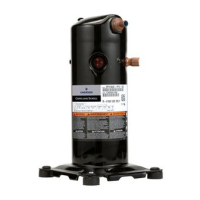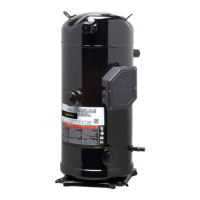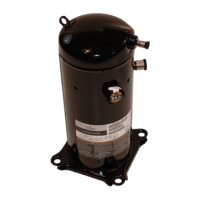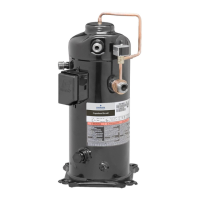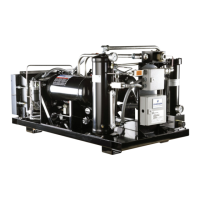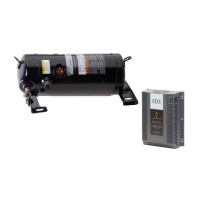condensing at 5400 RPM. If airborne sound attenuation
is required for the application, Fabricating Services
(www.fabsrv.com) is one manufacturer of custom sound
solutions
Expansion Devices
The expansion device is a crucial component of the
variable capacity system. Fixed-orifice devices, which
are chosen or optimized at one particular operating
condition, will not have the ability to control the
refrigerant flow across a wide range of operating
pressures and flow rates required by the variable
capacity system.
To better control superheat, an electronic expansion
valve (EXV) is recommended. Electronic expansion
valves have the ability to more precisely control
superheat at lower settings over a wider operating
range than a TXV. They also have the capability to be
driven completely closed during the off-cycle,
minimizing off-cycle migration.
Regardless of which expansion device is used, the
manufacturer's recommendations on the application of
the valve should be followed in all cases.
Reversing Valves
A variable speed scroll has a real advantage during the
defrost cycle. By taking advantage of the higher
speeds and flow rates, defrost time will typically be
shorter than a system with a fixed or two-step capacity
compressor. This reduces the time heat is required
during the defrost cycle.
CAUTION Reversing valve sizing must be within
the guidelines of the valve manufacturer. Required
pressure drop to ensure valve shifting must be
measured throughout the operating range of the
unit and compared to the valve manufacturer’s
data. Conditions that result in low flow rates and
low pressure drop across the valve can result in a
valve not shifting. This can result in a condition
where the compressor appears to be not pumping
(i.e. balanced pressure). It can also result in
elevated compressor sound levels. During a defrost
cycle, when the reversing valve abruptly changes the
refrigerant flow direction, the suction and discharge
pressures will go outside of the operating envelope.
The condition will usually cross the diagonal line
representing the lower right hand corner of the
envelope. The sound that the compressor makes
during this transition period is normal, and the duration
of the sound will depend on the coil volume, outdoor
ambient, and system charge.
The reversing valve solenoid should be wired so that
the valve does not reverse when the system is shut off
by the operating thermostat in the heating or cooling
mode. If the valve is allowed to reverse at the system
shutoff, suction and discharge pressures are reversed
to the compressor. This will result in pressures
equalizing through the compressor which can cause
the compressor to slowly rotate backwards until the
pressures equalize. This condition does not affect the
compressor durability but can cause unexpected sound
after the compressor is turned off.
Accumulators
The use of accumulators is very dependent on the
application. The variable speed scroll has an inherent
ability to handle liquid refrigerant during occasional
operating flood back situations. Systems designed
with EXV or TXV refrigerant control may not require
an accumulator if testing assures the system designer
that there will be no flood back throughout the
operating range. To test for flood back conditions and
to determine if the accumulator or EXV/TXV design is
adequate, please see the Application Tests section.
A large-area protective screen no finer than 30x30
mesh is required to protect this small orifice from
plugging. Tests have shown that a small screen with
a fine mesh can easily become plugged causing oil
starvation to the compressor bearings. The size of the
accumulator depends upon the operating range of the
system and the amount of system refrigerant charge.
System modeling indicates that heat pumps that
operate down to and below 0°F (-18°C) will require an
accumulator that can hold around 70% to 75% of the
system charge. Behavior of the accumulator and its
ability to prevent liquid slugging and subsequent oil
pump-out at the beginning and end of the defrost
cycle should be assessed during system
development. This will require special accumulators
and compressors with sight tubes and/or sight
glasses for monitoring refrigerant and oil levels.
Off-Cycle Migration Control
Off-cycle migration control is important for long term
compressor reliability and to minimize nuisance
complaints associated with flooded start conditions.
Off-cycle migration control is recommended when the
system charge exceeds 15.0 lbs (7 kg). Off-cycle
migration control is required when the system charge
exceeds 18 lbs (8 kg). In lieu of using a conventional
wrap-around crankcase heater, the drive has a
programmable feature that will utilize the motor
windings.
